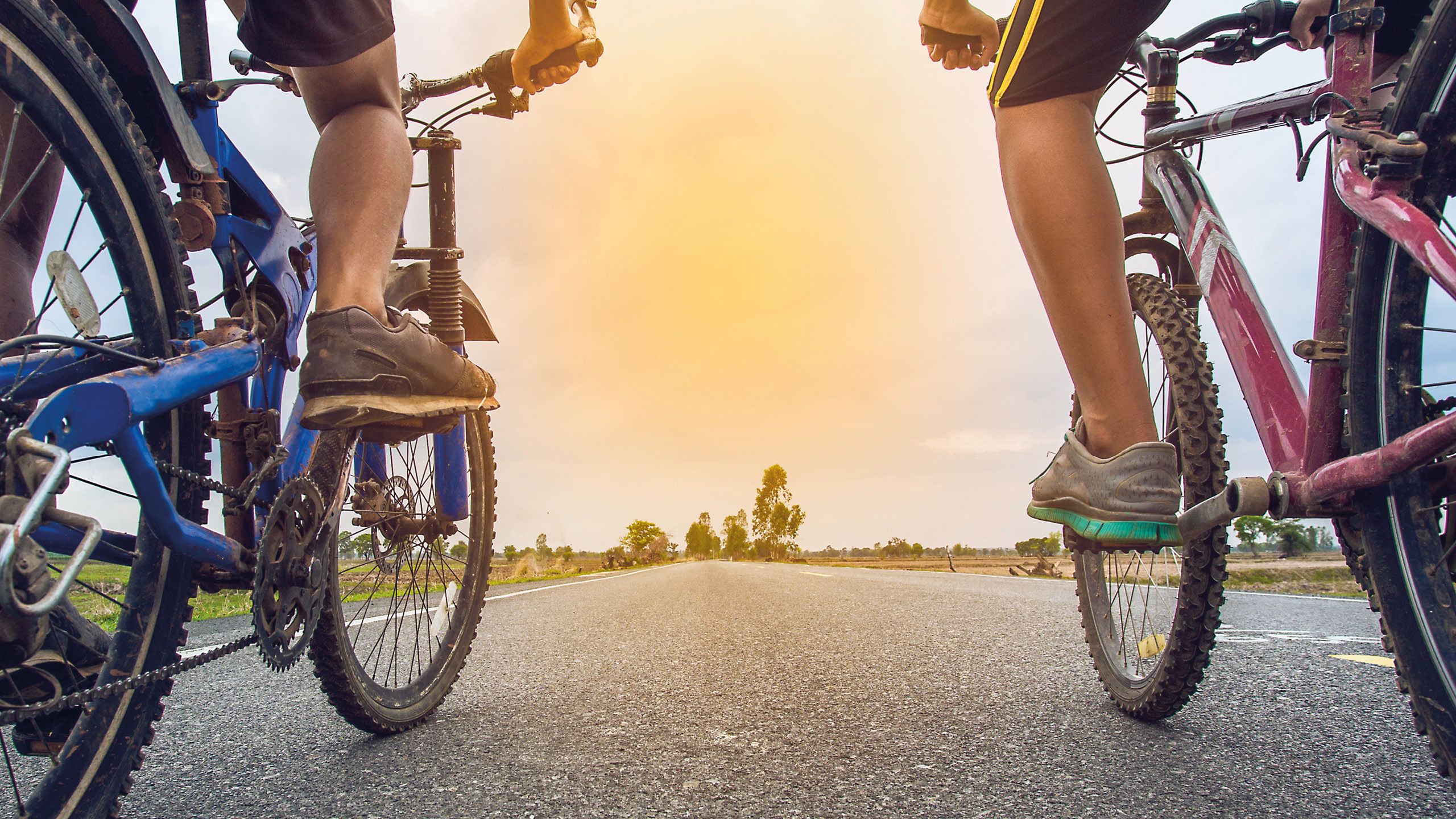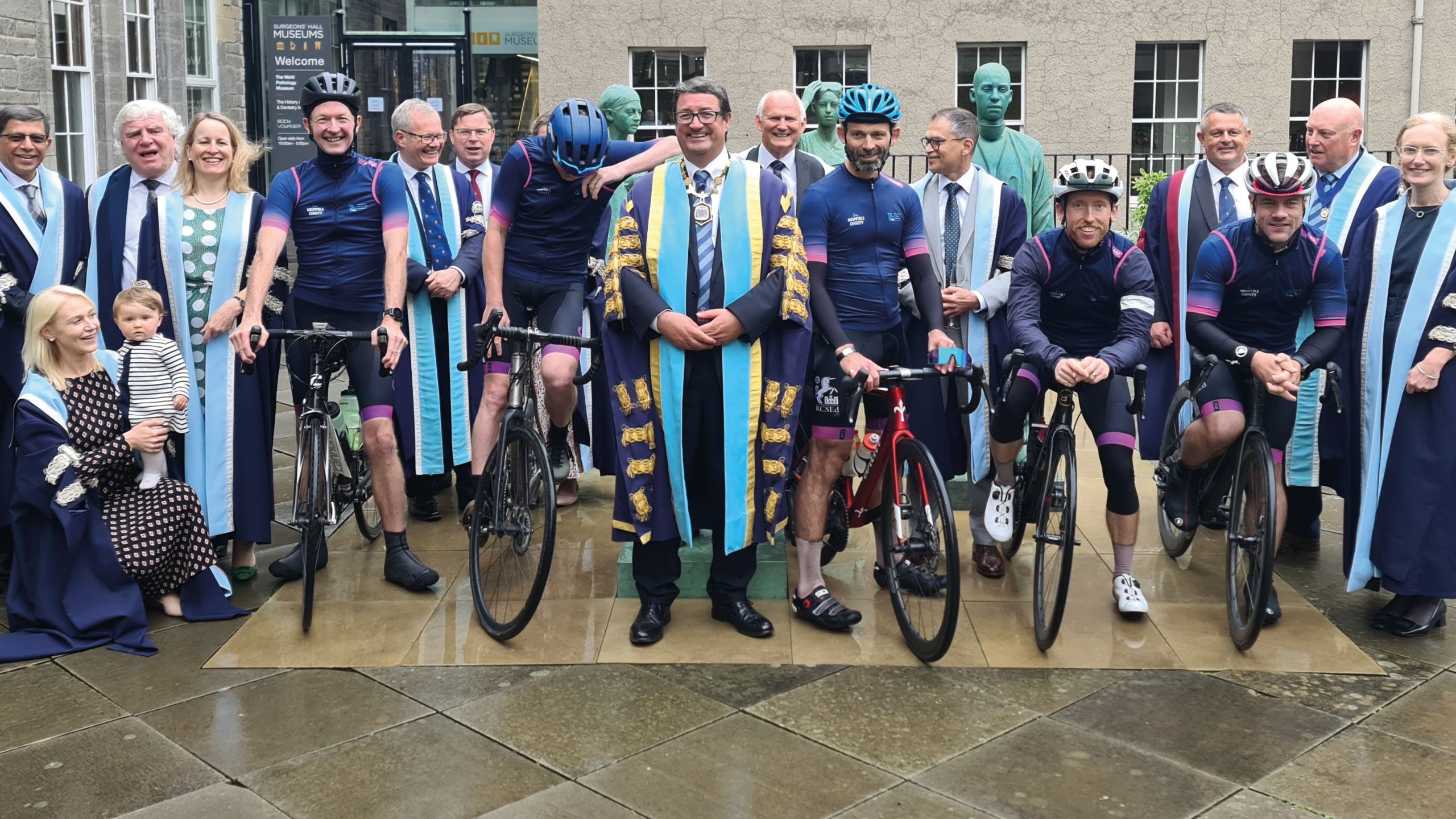Wheels
in motion
Barney Green on the links
between cycling and wellbeing


Barney Green: Consultant Vascular Surgeon,
north-east England and Director of the RCSEd RSA Network
In response to the growing national epidemic of violent crime, specifically knife crime, in June 2023 a group of RCSEd College Members and colleagues in the wider NHS took part in a travelling symposium that met with 100 12–16-year-olds in the north-east and north-west of England.
By showcasing their diverse careers in the NHS and highlighting access to these careers through a widening participation programme, it was hoped the young people would appreciate how inclusive and attainable a career in the NHS is, be inspired to make positive and hopeful choices for their own future and determine to eschew life choices that result in violence.
With the symposium members set to cycle a distance totalling 400km, the potential for bonus educational points on the benefits of a healthy lifestyle was hard to pass up. In matching College-branded Lycra, the team hit the road.
Pedal power
Cycling is more popular than ever, with the COVID-19 pandemic believed to be responsible for making cycling more attractive as a mode of transport and recreational activity. Globally, bike sales rocketed, with manufacturers running so low on stock that shops were unable to supply the most basic of spares for repairs. In some parts of the world not only has the boom triggered a shift to carbon-positive households, carbon emissions in urban areas have fallen in response to a change in infrastructure, such as new cycle lanes1. From the leisure cyclist to competitive ultra cyclists, what seems to be a theme is the link between cycling and wellbeing.
The physical health benefits of exercise are well documented, with recent published data from Sport England suggesting one in every six deaths is caused by inactivity2. Their research demonstrated that those who do the least activity stand to benefit the most from exercising more, even with small changes like gentle jogging, swimming or playing rounders in the park. The mode of exercise chosen will depend on individual preference, but some activities pose a greater risk of physical injury with subsequent detriment to mental health if one relies on that activity for wellbeing.
Take running. Recreational runners will, on average, experience at least one injury in about 225 hours of running, with nearly half of all recreational runners sustaining an injury of some form3.

Cycling has been shown to be safer than people think. On Britain’s roads there are nine to 10 million cycle trips for every cyclist fatality and for every 1,000 hours of cycling there were just 0.045 injuries (all severities combined) reported to the police from 2015 to 2019; three-quarters of these injuries were slight4.
It is no surprise that, as the health benefits of cycling outweigh the risks, it is encouraged by anchor institutions, including the British Heart Foundation.
Clearly it is unreasonable to believe that wellbeing is a result of the attainment and maintenance of good physical health. And wellbeing, in its truest sense, is so much more profound than the superficialities experienced from a sense of comfort, or health, or happiness.
Wellbeing, in all its richness, relates to a sense of completeness, fulfilment, meaning, purpose and value in spite of any adversity, challenge and affliction we may face in our daily lives. That is why Horatio Spafford, an American lawyer and Presbyterian Church elder, travelling to meet his grieving wife after learning of the tragic death of their four daughters on a transatlantic voyage on board the SS Ville du Havre in 1873, was able to pen the most unexpected and inspiring of hymnal lyrics still sung around the world to this day:
When peace like a river, attendeth my way,
When sorrows like sea billows roll;
Whatever my lot, Thou hast taught me to say
It is well, it is well, with my soul.
How is that possible? How could his soul be ‘well’ in the midst of that devastation? This is not an outdated, archaic or religious mindset. It is also observed today, just as it was in the 1800s.
Measuring wellbeing
The Thriving Places Index (TPI) is a framework that identifies local conditions for wellbeing and measures whether those conditions are being delivered fairly and sustainably5. Arranging the index under three headings (local conditions, equality and sustainability) and sub-dividing them into policy and action domains, the TPI helps provide information on the different elements that support the wellbeing of people, places and the planet. It is possible to view the score card for each local authority in England and Wales. What is startling is that areas that score lower than average across multiple domains may still record high levels of personal wellbeing. For example, in Redcar and Cleveland, which score very badly for mental health, overall health status, healthy and risky behaviours, and mortality and life expectancy, people report feeling happy and worthwhile with strong scores for life satisfaction and low levels of anxiety6.
Imperatively, we must guard ourselves against the fallacy that wellbeing is linked only to physical health; or relates to the absence of pain and suffering in life. And so that brings us back to cycling.
There is a strong belief in our contemporary society that we are owed a work–life balance. Like riding a bicycle, balance does not come from the equilibrium between two conflicting and opposing elements (the pedals), balance comes from a rhythm; the pedal is up, the pedal is down, the cadence is fast, the cadence is slow, outright power and delicate control. This rhythm brings balance on the bike, then progress, success and contentment.
True wellbeing is possible in spite of the disharmony and disruption in our relationships and circumstances when there is a deep grasp of the rise and fall of life events, and the establishment of a reassuring and dependable rhythm we can use to navigate our way forward. The analogy of cycling to describe wellbeing far exceeds the obvious of healthy body, healthy mind. There is more to be said about those things that engender wellbeing in us that are observed in the parallel of cycling: identity and common value, training and resilience, individuality and togetherness, role and function.
Learn to find the rhythm that brings you balance, helps you deal with the dark nights and joyful days, completes you, enables you to find fulfilment and results in your deepest sense of wellbeing. If you need to do that on a bike, there will be a myriad of teammates prepared to journey with you.

|
References 1. Rérat P, Haldimann L, Widmer H. Cycling in the era of COVID-19: The effects of the pandemic and pop-up cycle lanes on cycling practices. Transp Res Interdiscip Perspect 2022; 15, 100677. www.sportengland.org/ 2. research-and-data/research/inactive-people 4. www.cyclinguk.org/statistics 5. www.thrivingplaces index.org/page/about/about-the-tpi 6. www.thrivingplaces index.org/candidates/E06000003 |
